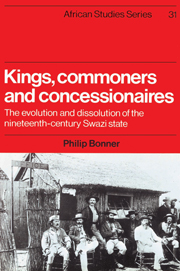 Kings, Commoners and Concessionaires
Kings, Commoners and Concessionaires Book contents
- Frontmatter
- Contents
- List of maps
- List of figures
- Preface
- Map 1 Modern Swaziland
- Map 2 Chiefdoms c. 1820
- 1 Introduction
- 2 The northern Nguni states 1700–1815
- 3 The conquest state 1820–1838
- 4 Factions and fissions: Mswati's early years
- 5 The balance tilts: Swazi–Boer relations 1852–1865
- 6 The deepening and widening of Dlamini power 1852–1865
- 7 Regency and retreat 1865–1874
- 8 Confederation, containment and conciliar rule: Mbandzeni's apprenticeship 1874–1881
- 9 The puff–adder stirs: Mbandzeni and the beginnings of concessions 1881–1886
- 10 The conquest by concessions 1886–1889
- 11 Conclusion
- Appendix
- Notes
- Bibliography
- Index
- KINGS, COMMONERS AND CONCESSIONAIRES
2 - The northern Nguni states 1700–1815
Published online by Cambridge University Press: 22 September 2009
- Frontmatter
- Contents
- List of maps
- List of figures
- Preface
- Map 1 Modern Swaziland
- Map 2 Chiefdoms c. 1820
- 1 Introduction
- 2 The northern Nguni states 1700–1815
- 3 The conquest state 1820–1838
- 4 Factions and fissions: Mswati's early years
- 5 The balance tilts: Swazi–Boer relations 1852–1865
- 6 The deepening and widening of Dlamini power 1852–1865
- 7 Regency and retreat 1865–1874
- 8 Confederation, containment and conciliar rule: Mbandzeni's apprenticeship 1874–1881
- 9 The puff–adder stirs: Mbandzeni and the beginnings of concessions 1881–1886
- 10 The conquest by concessions 1886–1889
- 11 Conclusion
- Appendix
- Notes
- Bibliography
- Index
- KINGS, COMMONERS AND CONCESSIONAIRES
Summary
The history of the Ngwane, or at any rate, of their royal line, the Dlamini, stretches back far into the past. According to genealogies collected by James Stuart at the end of the nineteenth century, the Dlamini were able to trace their line of succession back some forty generations. Genealogies of this length are, sadly, notoriously subject to inflation, as many students of oral tradition will confirm. Eponyms, toponyms and patronyms are often included, as are the names of regents and contenders for the succession. Even outright fabrication can sometimes occur, when societies are suddenly faced with the need to create a remote past which sanctions the present. No reliable time depth can therefore be drawn from the king lists of the Dlamini, beyond saying that they seem to have lived in the vicinity of Delagoa Bay for some considerable time.
Ngwane history only dawns in the mid-eighteenth century. (The term ‘Ngwane’ is used here to designate the nucleus of what was later to become the Swazi, who took control of southern Swaziland (Eshiselweni) in the 1760s and 1770s. I have confined its use to the Eshiselweni period prior to the Ngwane's later expansion north. Thereafter I use the term ‘Swazi’ since there is evidence of its having been used from this time.) From this period genealogies become more detailed, and for the first time one finds agreement about the correct sequence of kings. Two reasons probably account for the change. The Dlamini were experiencing a period of crisis, precipitated by the efforts of the neighbouring Tembe to expand their monopoly of a burgeoning maritime trade, and were rent in the process by a series of dynastic feuds.
- Type
- Chapter
- Information
- Kings, Commoners and ConcessionairesThe Evolution and Dissolution of the Nineteenth-Century Swazi State, pp. 9 - 26Publisher: Cambridge University PressPrint publication year: 1983
